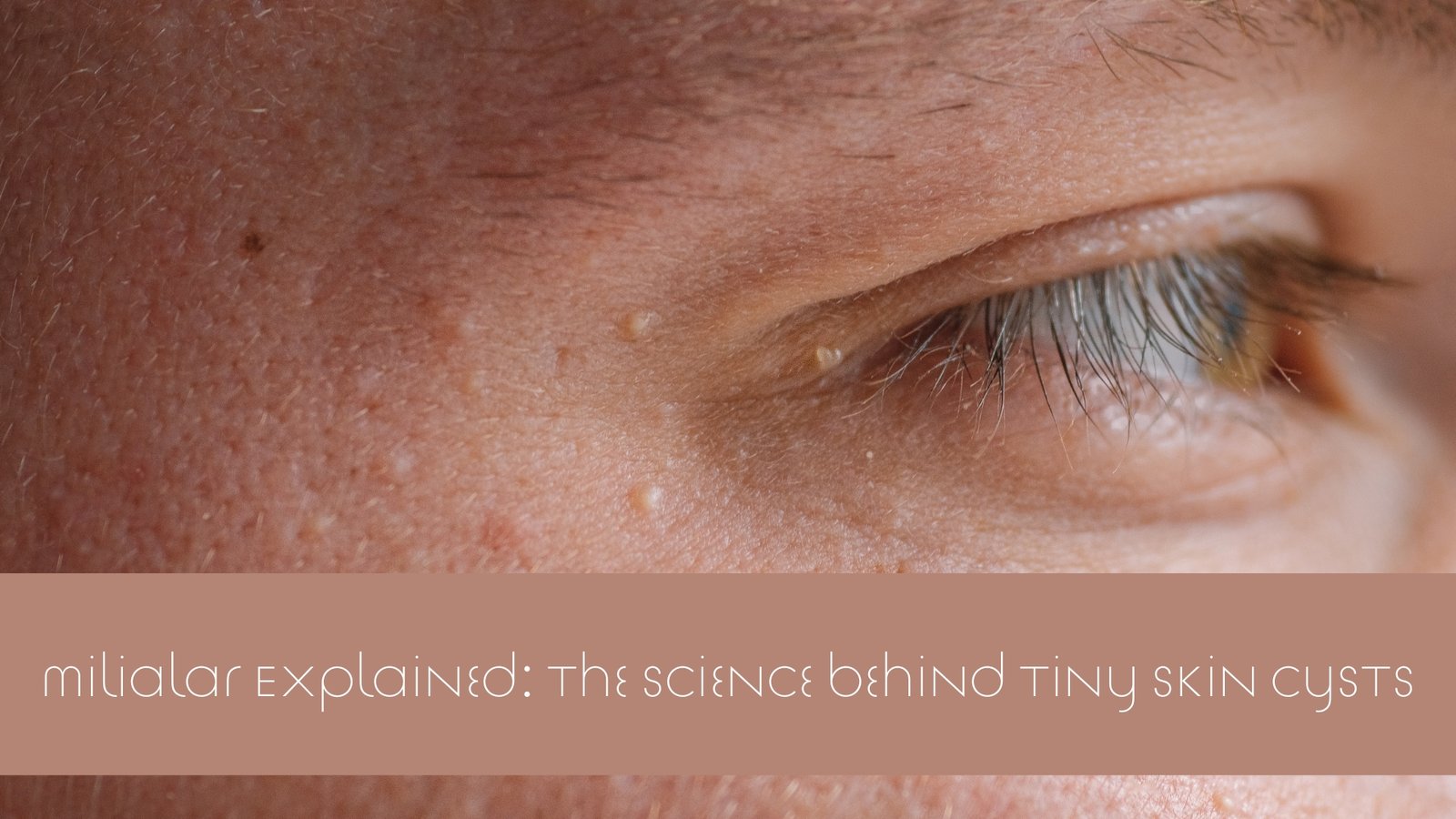Have you ever noticed tiny, white bumps on your skin that just won’t seem to go away? These may be milialar, also known as milial cysts. While they are generally harmless, understanding the science behind these small skin cysts can help you manage and prevent them effectively. In this blog post, we will explore what milialar are, what causes them, and how you can deal with them on a daily basis.
Understanding Milialar – What Are They?
Milialar, small yet noticeable white bumps, primarily surface on the facial region but are not exclusive to it; they can appear anywhere on the body. These bumps arise when keratin, a natural protein found in the skin, becomes trapped beneath the skin’s outermost layer, leading to the formation of these tiny cysts. Unlike common misconceptions, they are not a result of poor hygiene or a direct consequence of acne. Their appearance, characterized by their white or sometimes yellowish color, makes them distinct from the typical blemishes associated with acne. Milialar’s development is intrinsically linked to the skin’s renewal process. As dead skin cells are shed, some fail to exfoliate properly and instead accumulate, getting encased in small pockets within the skin. This process results in the dome-shaped bumps that are palpable and often visible to the naked eye. Though they can arise at any age, they are notably prevalent in newborns, indicating a universal predisposition that spans across age groups. Despite their benign nature, understanding the nuances of their formation is crucial in addressing their presence and implementing effective skincare routines to mitigate their development.
The Common Causes Behind Milialar Formation
Milialar emerge due to a variety of factors, each playing a significant role in the development of these small cysts beneath the skin. One pivotal cause is the application of skincare products that are overly dense or rich in oils, which can lead to the obstruction of pores. This blockage traps dead skin cells, which should otherwise be shed, contributing to the formation of milialar. Additionally, exposure to the sun’s rays can cause the skin to thicken, impeding the natural exfoliation process and thereby increasing the likelihood of cyst development. Another critical aspect to consider is the genetic predisposition some individuals have towards milialar. This inherited tendency can influence the skin’s behavior and its renewal cycle, making some more susceptible to these tiny cysts than others. Furthermore, lifestyle choices and certain skin conditions, such as prolonged use of steroid creams, can exacerbate the risk of developing milialar by altering the skin’s texture and its ability to exfoliate naturally. Understanding these causes is essential for adopting preventive strategies and addressing the root of the problem, rather than merely treating its symptoms. Recognizing the diverse factors at play can empower individuals to make informed decisions about their skincare routines and lifestyle choices to minimize the occurrence of milialar.
Special Focus on Vulval Milial Cysts
Vulval milial cysts present a unique consideration in the realm of skin cysts, manifesting as small, benign bumps along the vulva. These cysts, akin to their facial counterparts, result from the trapping of keratin beneath the skin’s surface but occur in the sensitive and often overlooked area of the vulva. Due to the delicate nature of this area, the approach to preventing and managing vulval milial cysts differs slightly. Emphasis is placed on gentle care, highlighting the importance of non-irritating hygiene practices. It is recommended to avoid harsh cleansers or scrubs that can aggravate the skin, instead opting for mild, fragrance-free products to maintain the area’s natural balance.
The occurrence of vulval milial cysts might also prompt a reevaluation of the products used in close proximity to this area, including lotions and body washes, to ensure they do not contribute to pore blockage. For individuals experiencing vulval milial cysts, the temptation to manually extract them should be avoided due to the risk of infection and the sensitive nature of the skin involved. Instead, if these cysts become a source of discomfort or concern, consulting with a dermatologist or gynecologist is advised. These professionals can offer guidance tailored to the vulvar area, ensuring treatments are both effective and mindful of the vulva’s sensitivity. While vulval milial cysts are less discussed than their facial counterparts, understanding their nature and how to care for them contributes to overall skin health and comfort.
Preventive Measures and Daily Skincare Tips
Maintaining a skin-friendly lifestyle is paramount in preventing the emergence of milialar. One foundational step involves integrating gentle exfoliation into your routine. This helps in the removal of dead skin cells that could potentially clog pores and form milialar. However, it’s essential to find a balance to avoid over-exfoliation, which can damage the skin barrier and make the situation worse.
Choosing the right skincare products is another crucial aspect. Opt for lightweight, non-comedogenic formulas that moisturize without leaving a heavy residue that could block pores. Paying attention to the ingredients in your skincare is also vital; look for products containing ingredients like salicylic acid or glycolic acid, which help in promoting cell turnover and preventing the buildup of keratin beneath the skin’s surface.
Proper hydration plays a significant role in maintaining skin health. Drinking ample water throughout the day can help keep your skin hydrated from the inside, complementing your topical skincare regimen.
Regarding makeup, selecting mineral-based or oil-free products can decrease the risk of pore obstruction. Also, ensure you thoroughly remove makeup before going to bed to let your skin breathe and repair overnight.
Sun protection is a critical factor that cannot be overstressed. Applying a broad-spectrum sunscreen daily protects the skin from harmful UV rays that can cause thickening of the skin, thereby reducing the skin’s natural shedding process and potentially leading to milialar formation.
By incorporating these preventive measures and skincare tips into your daily routine, you can help keep your skin healthy and minimize the risk of developing milialar. Each small step contributes to a larger strategy aimed at maintaining the skin’s integrity and appearance.
Professional Treatments and Home Remedies for Milialar
For those dealing with milialar and seeking solutions beyond daily skincare routines, a blend of professional treatments and at-home care may provide relief. Dermatologists often perform safe and effective extractions, utilizing sterile tools to gently remove milialar without harming the surrounding skin. Another professional approach is the use of chemical peels, which exfoliate the skin at a deeper level, encouraging the turnover of skin cells and helping to clear the blockages that lead to milial cyst formation.
Laser therapy represents another cutting-edge option, targeting the cysts with focused light to remove them without physical extraction. This method minimizes the risk of scarring and infection. For particularly stubborn or recurrent milialar, microdermabrasion can be employed, a process that sands away the top layer of skin to unclog pores and eliminate dead skin cells.
At-home remedies can complement these professional treatments, offering daily maintenance and prevention. Regular, gentle exfoliation with a soft scrub can help keep the skin clear, while topical applications of retinoids accelerate cell renewal and prevent keratin buildup. It’s important, however, to use these products judiciously, as overuse can irritate the skin and exacerbate the problem.
Natural remedies, such as honey masks or castor oil applications, have been anecdotally reported to assist in managing milialar, thanks to their moisturizing and antibacterial properties. However, their effectiveness may vary, and they should not replace consultation with a skincare professional.
Engaging in a comprehensive approach that includes both professional treatments and home care strategies can significantly improve the appearance of milialar and contribute to healthier, clearer skin.
Must Read: Discover Oridzin: The Secret Flavonoid in Apple Peels
When to See a Dermatologist About Milialar
Navigating the world of milialar on your own can sometimes lead to uncertainty, especially when standard care practices don’t yield the expected results. Consulting with a dermatologist becomes a crucial step for those who find themselves grappling with an extensive spread of milialar, experiencing discomfort, or witnessing no improvement despite diligent home care. Dermatologists are equipped with the expertise to assess your skin’s unique needs, offering targeted treatments that may include professional extraction, laser therapy, or prescription medications not available over the counter.
In addition to addressing persistent or troublesome milialar, a dermatologist’s input can be invaluable for individuals who may have underlying skin conditions contributing to their milialar formation. Conditions such as rosacea or eczema can complicate the presence and treatment of milialar, necessitating a tailored approach that only a skin care professional can provide. Moreover, a dermatologist can help distinguish milialar from other skin concerns that may mimic their appearance, ensuring that you receive the most appropriate care.
Seeking out a dermatologist for milialar might feel like a significant step, particularly for those who have managed their skin care independently. However, this proactive approach can illuminate new pathways to clearer skin, leveraging advanced treatments and expert guidance. Remember, your journey to healthy skin doesn’t have to be navigated alone. A dermatologist not only offers solutions for immediate concerns but also lays the groundwork for long-term skin health, helping to prevent future occurrences of milialar and bolstering your overall skincare regimen.





